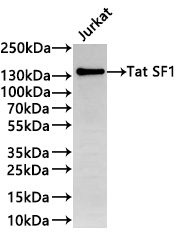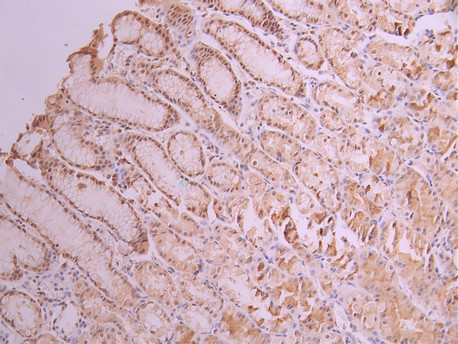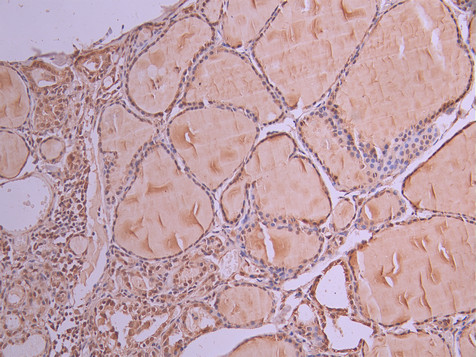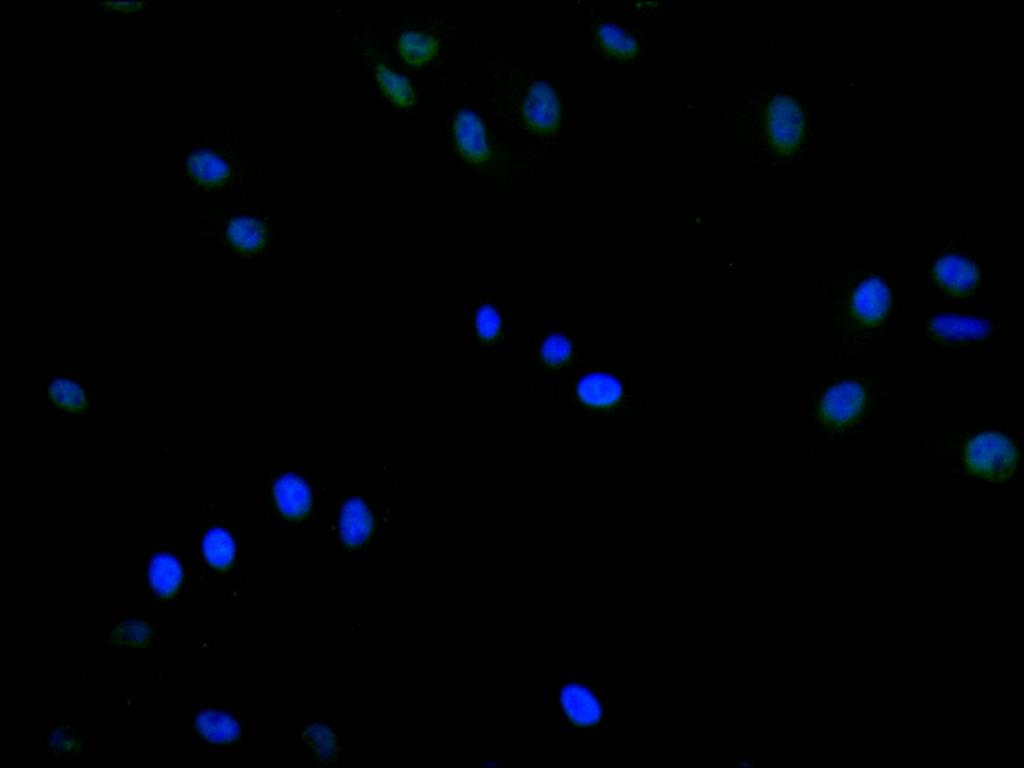HTATSF1 Recombinant Monoclonal Antibody
-
中文名稱:HTATSF1 Recombinant Monoclonal Antibody
-
貨號:CSB-RA824594A0HU
-
規格:¥1320
-
圖片:
-
Western Blot
Positive WB detected in: Jurkat whole cell lysate(30μg)
All lanes: Tat SF1 antibody at 1:1000
Secondary
Goat polyclonal to rabbit IgG at 1/40000 dilution
Predicted band size: 86 kDa
Observed band size: 140 kDa
Exposure time:3min -
IHC image of CSB-RA824594A0HU diluted at 1:100 and staining in paraffin-embedded human gastric cancer performed on a Leica BondTM system. After dewaxing and hydration, antigen retrieval was mediated by high pressure in a citrate buffer (pH 6.0). Section was blocked with 10% normal goat serum 30min at RT. Then primary antibody (1% BSA) was incubated at 4°C overnight. The primary is detected by a Goat anti-rabbit polymer IgG labeled by HRP and visualized using 0.05% DAB.
-
IHC image of CSB-RA824594A0HU diluted at 1:100 and staining in paraffin-embedded human thyroid tissue performed on a Leica BondTM system. After dewaxing and hydration, antigen retrieval was mediated by high pressure in a citrate buffer (pH 6.0). Section was blocked with 10% normal goat serum 30min at RT. Then primary antibody (1% BSA) was incubated at 4°C overnight. The primary is detected by a Goat anti-rabbit polymer IgG labeled by HRP and visualized using 0.05% DAB.
-
Immunofluorescence staining of Hela cell with CSB-RA824594A0HU at 1:50, counter-stained with DAPI. The cells were fixed in 4% formaldehyde, permeabilized using 0.2% Triton X-100 and blocked in 10% normal Goat Serum. The cells were then incubated with the antibody overnight at 4°C. The secondary antibody was Alexa Fluor 488-congugated AffiniPure Goat Anti-Rabbit IgG(H+L).
-
-
其他:
產品詳情
-
Uniprot No.:
-
基因名:HTATSF1
-
別名:HIV Tat-specific factor 1 (Tat-SF1), HTATSF1
-
反應種屬:Human
-
免疫原:A synthesized peptide from human HTATSF1 protein
-
免疫原種屬:Homo sapiens (Human)
-
標記方式:Non-conjugated
-
克隆類型:Monoclonal
-
抗體亞型:Rabbit IgG
-
純化方式:Affinity-chromatography
-
克隆號:6B7
-
濃度:It differs from different batches. Please contact us to confirm it.
-
保存緩沖液:Preservative: 0.03% Proclin 300
Constituents: 50% Glycerol, 0.01M PBS, PH 7.4 -
產品提供形式:Liquid
-
應用范圍:ELISA, WB, IHC, IF
-
推薦稀釋比:
Application Recommended Dilution WB 1:500-1:2000 IHC 1:50-1:200 IF 1:50-1:200 -
Protocols:
-
儲存條件:Upon receipt, store at -20°C or -80°C. Avoid repeated freeze.
-
貨期:Basically, we can dispatch the products out in 1-3 working days after receiving your orders. Delivery time maybe differs from different purchasing way or location, please kindly consult your local distributors for specific delivery time.
-
用途:For Research Use Only. Not for use in diagnostic or therapeutic procedures.
相關產品
靶點詳情
-
功能:Functions as a general transcription factor playing a role in the process of transcriptional elongation. May mediate the reciprocal stimulatory effect of splicing on transcriptional elongation. In case of infection by HIV-1, it is up-regulated by the HIV-1 proteins NEF and gp120, acts as a cofactor required for the Tat-enhanced transcription of the virus.
-
基因功能參考文獻:
- This study validates Tat-SF1 as an HDF in CD4+ T cell-derived SupT1 cells. PMID: 23153325
- these findings suggest that Tat-SF1 functions independently in transcription and splicing of cellular genes. PMID: 21282347
- These results support the notion that Tat-induced neuropathogenesis is mediated by multiple mechanisms involving both intracellular and extracellular Tat protein. PMID: 15050687
- phosphorylated by P-TEFb kinase during HIV-1 transcription in Tat/TAR dependent manner PMID: 15564463
- Intracellular HIV-1 Tat protein represses constitutive LMP2 transcription increasing proteasome activity by interfering with the binding of IRF-1 to STAT1 PMID: 16512786
- Tat-SF1 is not required for regulating HIV-1 transcription, but is required for maintaining the ratios of different classes of HIV-1 transcripts. PMID: 19479034
顯示更多
收起更多
-
亞細胞定位:Nucleus.
-
蛋白家族:HTATSF1 family
-
組織特異性:Widely expressed.
-
數據庫鏈接:
Most popular with customers
-
-
YWHAB Recombinant Monoclonal Antibody
Applications: ELISA, WB, IHC, IF, FC
Species Reactivity: Human, Mouse, Rat
-
-
-
-
-
-























